
Thutmose II was the fourth Pharaoh of the Eighteenth Dynasty of Egypt, and his reign is generally dated from 1493 to 1479 BC. Little is known about him and he is overshadowed by his father Thutmose I, half-sister and wife Hatshepsut, and son Thutmose III. He died around the age of 30 and his body was found in the Deir el-Bahri Cache above the Mortuary Temple of Hatshepsut.

Neferkare Setepenre Ramesses IX was the eighth pharaoh of the Twentieth Dynasty of Egypt. He was the third longest serving king of this Dynasty after Ramesses III and Ramesses XI. He is now believed to have assumed the throne on I Akhet day 21 based on evidence presented by Jürgen von Beckerath in a 1984 GM article. According to the latest archaeological information, Ramesses IX died in Regnal Year 19 I Peret day 27 of his reign. Therefore, he enjoyed a reign of 18 years, 4 months and 6 days. His throne name, Neferkare Setepenre, means "Beautiful Is The Soul of Re, Chosen of Re." Ramesses IX is believed to be the son of Mentuherkhepeshef, a son of Ramesses III, since Mentuherkhopshef's wife, the lady Takhat bears the prominent title of King's Mother on the walls of tomb KV10, which she usurped and reused in the late 20th Dynasty; no other 20th Dynasty king is known to have had a mother with this name. Ramesses IX was, therefore, probably a grandson of Ramesses III.

Seti II was the fifth pharaoh of the Nineteenth Dynasty of Egypt and reigned from c. 1203 BC to 1197 BC. His throne name, Userkheperure Setepenre, means "Powerful are the manifestations of Re, the chosen one of Re." He was the son of Merneptah and Isetnofret II and occupied the throne during a period known for dynastic intrigue and short reigns, and his rule was no different. Seti II had to deal with many serious plots, most significantly the accession of a rival king named Amenmesse, possibly a half brother, who seized control over Thebes and Nubia in Upper Egypt during his second to fourth regnal years.
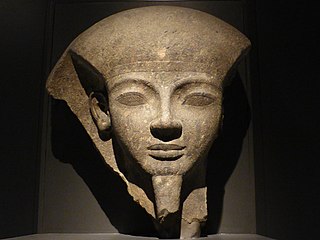
Ramesses VI Nebmaatre-Meryamun was the fifth ruler of the Twentieth Dynasty of Egypt. He reigned for about eight years in the mid-to-late 12th century BC and was a son of Ramesses III and queen Iset Ta-Hemdjert. As a prince, he was known as Ramesses Amunherkhepeshef and held the titles of royal scribe and cavalry general. He was succeeded by his son, Ramesses VII Itamun, whom he had fathered with queen Nubkhesbed.
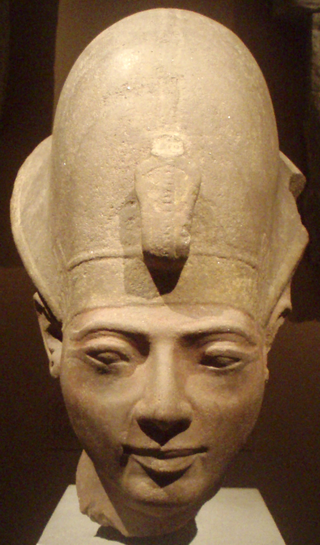
Amenmesse was the fifth pharaoh of the Nineteenth Dynasty in Ancient Egypt, possibly the son of Merneptah and Queen Takhat. Others consider him to be one of the innumerable sons of Ramesses II. Very little is known about this pharaoh, who ruled Egypt for only three to four years. Various Egyptologists date his reign between 1202 BC–1199 BC or 1203 BC–1200 BC with others giving an accession date of 1200 BC. Amenmesse means "born of or fashioned by Amun" in Egyptian. Additionally, his nomen can be found with the epithet Heqa-waset, which means "Ruler of Thebes". His royal name was Menmire Setepenre.
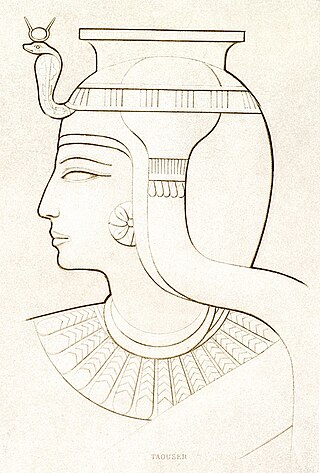
Tausret, also spelled Tawosret or Twosret was the last known ruler and the final pharaoh of the Nineteenth Dynasty of Egypt.
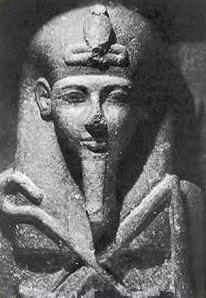
Akhenre Setepenre Siptah or Merneptah Siptah was the penultimate ruler of the Nineteenth Dynasty of Egypt. His father's identity is currently unknown. Both Seti II and Amenmesse have been suggested although the fact that Siptah later changed his royal name or nomen to Merneptah Siptah after his Year 2 suggests rather that his father was Merneptah. If correct, this would make Siptah and Seti II half-brothers since both of them were sons of Merneptah.

Tomb KV10, located in the Valley of the Kings near the modern-day Egyptian city of Luxor, was cut and decorated for the burial of Pharaoh Amenmesse of the Nineteenth Dynasty of Ancient Egypt. However, there is no proof that he was actually buried here. Later, the decoration was replaced with scenes for Takhat and Baketwernel—two royal women dating to the late 20th Dynasty.

Takhat was an ancient Egyptian princess and queen of the 19th Dynasty, the mother of the usurper pharaoh Amenmesse.
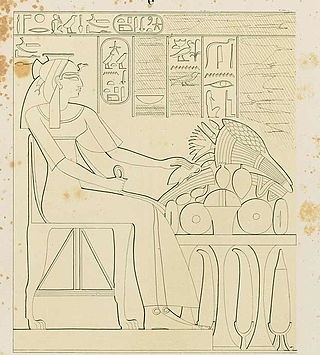
Duatentopet or Tentopet was an ancient Egyptian queen of the 20th Dynasty, the wife of Pharaoh Ramesses IV, and mother of Ramesses V. Even though the identity of Ramesses IV's wife has not been clearly stated in history, she is considered the most likely candidate by virtue of the titles she was given and which were found listed in her tomb (QV74).
Takhat was the mother of ancient Egyptian Pharaoh Ramesses IX of the 20th Dynasty.

Tyti was an ancient Egyptian queen of the 20th Dynasty. A wife and sister of Ramesses III and possibly the mother of Ramesses IV.
Neserkauhor was an Ancient Egyptian prince, son of pharaoh Djedkare Isesi, during the second half of Fifth Dynasty. Neserkauhor was buried in Abusir, in an area known today as "Djedkare's family cemetery".

Roma called Roy was High Priest of Amun during the Nineteenth Dynasty of Egypt, at the end of the reign of Ramesses II and continued into the reigns of Merenptah and likely Seti II. Roma served as third and second priest of Amun and finally as first prophet of Amun. He was also a count (h3ty-a), a prince (iry-pat) and a divine father pure of hands.

Hori was a vizier of Ancient Egypt. He served during the reign of pharaohs Seti II, Siptah, Twosret, Setnakhte and Ramesses III.
Khaemtir was a Viceroy of Kush and Vizier of Ancient Egypt. He served during the reign of Amenmesse and Seti II.

Sekhemre Sementawy Djehuty was a minor king reigning over parts of Upper Egypt during the Second Intermediate Period.

Siese the Younger was the Superintendent of the Granary during the reign of Ramesses II and Merenptah. Siese and his family came from Asyut.
Anuketemheb was an ancient Egyptian princess and queen of the 19th or the 20th Dynasty. She is known from only one artifact, a red granite sarcophagus lid which was originally hers but was later reused for Takhat, the mother of Amenmesse and was discovered in the tomb KV10.

The end of the 19th Dynasty of Ancient Egypt is a period of short-reigning rulers c. 1203-1187 BC. After the death of Merneptah, there was a conflict for the throne between Seti II and Amenmesse, which eventually resulted in the victory of Seti II. Seti II's reign was short, as he died within a year of regaining power. His widow, Tausret, took control with the support of Bay and the puppet Pharaoh Siptah. However, Tausret later eliminated Bay, and Siptah died under mysterious circumstances. This soon triggered a new power struggle between Tausret and Setnakhte. The struggle culminated in the triumph of Setnakhte, who is now remembered as the founder of the 20th Dynasty.















